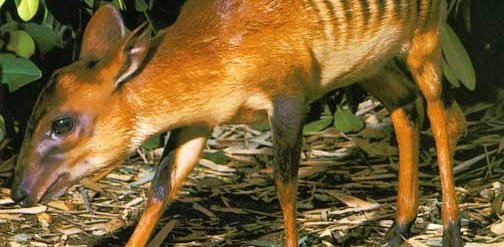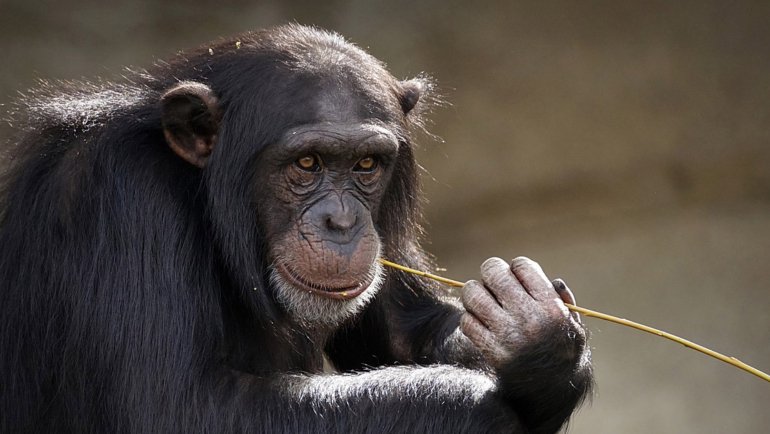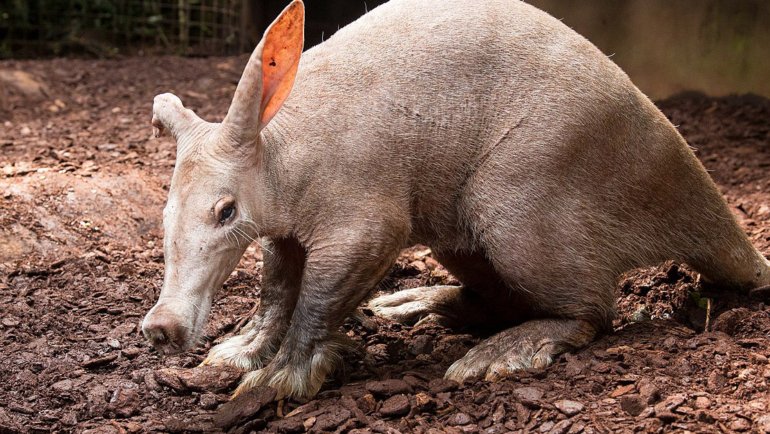Welcome to this comprehensive fact sheet on the caracal, a fascinating and elusive member of the feline family. Known for its striking appearance and remarkable agility, the caracal has intrigued wildlife enthusiasts and researchers alike.
This article aims to shed light on various aspects of the caracal, from its taxonomy and physical characteristics to its behavior and conservation status. If you’re curious to know more about this extraordinary creature, read on!
The Caracal at a Glance
Classification
| Kingdom: | Animalia |
| Phylum: | Chordata |
| Class: | Mammalia (Mammals) |
| Order: | Carnivora |
| Family: | Felidae |
| Genus: | Caracal |
| Species: | C. caracal |
Essential Information
| Average Size: | 30-35 inches (75-90 cm) in body length |
| Average Weight: | 29-40 pounds (13-18 kg) |
| Average Lifespan: | 12 years (wild), 17 years (captivity) |
| Geographical Range: | Africa, Middle East, parts of India and Pakistan |
| Conservation Status: | Least Concern (IUCN Red List) |
Species and Subspecies
The caracal (Caracal caracal) is generally considered a monotypic species, meaning there are no widely accepted subspecies. However, some taxonomists suggest that there may be regional variants that have yet to be formally classified.
Historically, a few subspecies have been proposed based on geographical locations, but these classifications are currently not widely recognized in scientific communities.
Although subspecies classification is not universally accepted, there are distinct populations of caracals in different parts of its geographical range—Africa, the Middle East, and the Indian subcontinent.
These populations may exhibit subtle differences in size, color, and behavior due to local environmental conditions, but more research is needed to confirm these observations.
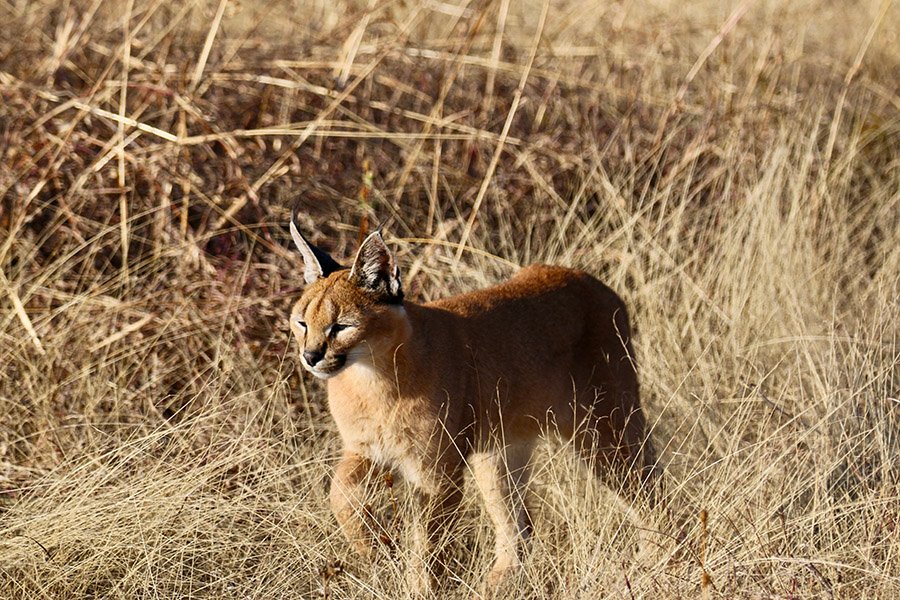
Description
The caracal is an exceptionally graceful and agile member of the feline family. Its most distinguishing features are its long, tufted ears, which are black and can be as long as 1.9 inches (4.8 cm).
The body is built for stealth and speed, with strong hind legs that can propel it to jump up to 10 feet (3 meters) in the air. The caracal has a short, dense coat that can range in color from reddish-brown to a more muted beige, allowing it to blend in with its natural surroundings.
Anatomically, the caracal possesses extremely sharp retractable claws, a powerful jaw, and keen eyesight adapted for both daytime and nighttime vision. These features make it an efficient predator capable of taking down a variety of prey.
There’s some sexual dimorphism in caracals; males are generally larger and heavier than females. Males typically weigh between 35-40 pounds (15.8-18.1 kg), while females weigh around 24-29 pounds (10.8-13.1 kg).
Habitat and Distribution
The caracal is a highly adaptable feline and can be found in a variety of habitats ranging from savannas and grasslands to more arid regions like deserts and scrublands. They have even been known to reside on the outskirts of urban areas.
However, they prefer terrains that offer some form of natural cover, like bushes and rocks, for stalking prey and resting during the day.
Geographically, the caracal is predominantly found in parts of Africa, particularly sub-Saharan Africa. It is also native to parts of the Middle East and extends its range into parts of India and Pakistan.
The distribution of caracals in these areas depends largely on the availability of suitable habitats and prey.

Behavior
Caracals are generally nocturnal or crepuscular animals, meaning they are most active during the early morning and late evening. They are known for their elusive behavior and tend to avoid human interaction whenever possible.
In terms of social structure, the caracal is a solitary animal, especially the males. Females may be seen with their offspring but generally avoid interaction with other adults outside of the mating season.
Communication among caracals is primarily through vocalizations like growls, hisses, and meows. They also mark their territory using scent markings from their facial glands and urine. Additionally, the position of their ears and the arching of their back can convey different emotional states or intentions to other caracals.
The caracal is also renowned for its incredible leaping ability, which it uses both for hunting and for evading predators. Their unique ear tufts are thought to enhance their communication by providing more distinct and expressive ear signals.
Diet and Feeding Behavior
The caracal is a carnivorous predator with a diet primarily consisting of small mammals, birds, and rodents. This includes hares, squirrels, and even small antelopes. They are also capable of taking down larger prey like young gazelles. Birds make up a significant portion of their diet, especially ground-dwelling birds like guinea fowl.
Caracals employ a stalk-and-ambush hunting technique, using their keen eyesight to spot prey from a distance before moving in for the kill. They are known for their extraordinary leaping ability, which allows them to catch birds in mid-air. A caracal can leap up to 10 feet (3 meters) in the air to swipe a bird from the sky.
Predators
The caracal faces few natural predators due to its agility, speed, and general elusiveness. However, larger carnivores like lions and hyenas can pose a threat, especially to younger or less experienced caracals.
Additionally, eagles may sometimes prey on juvenile caracals. Human activities, such as hunting and habitat destruction, pose the most significant threat to caracals.
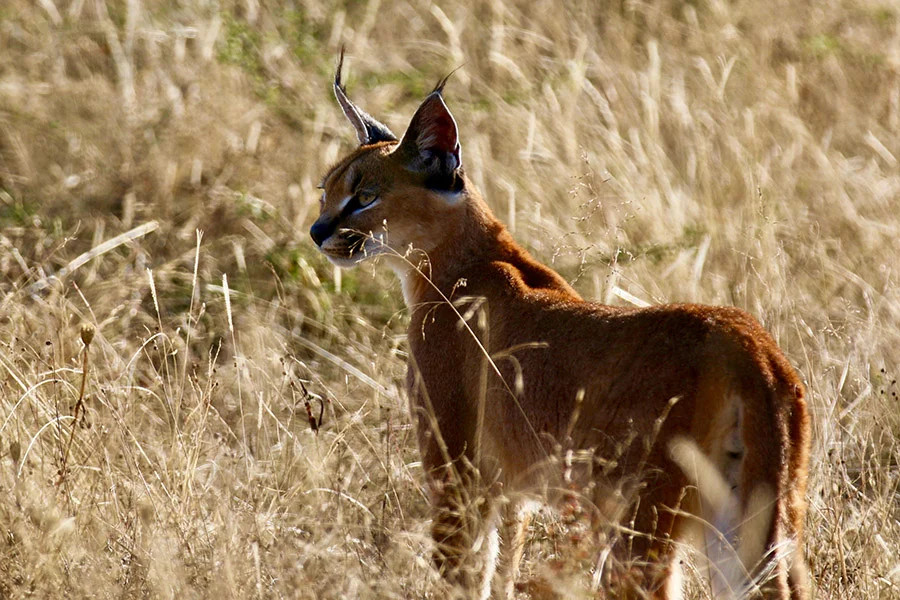
Reproduction and Life Cycle
Caracals breed year-round, but mating activity often peaks during the wet seasons when food is abundant. Females typically come into estrus for about a week and will mate with a dominant male in the territory.
The gestation period lasts approximately 78-81 days, after which a litter of 1 to 6 kittens is born. The young are born in a secluded den, usually among rocks or dense vegetation, and are cared for solely by the mother. The kittens are born blind and completely reliant on their mother for the first few weeks of life.
At around ten weeks, the young caracals are introduced to meat, and by three months, they are accompanying their mother on hunts. They become fully independent at about a year old but may remain in their mother’s territory for some time before moving off to establish territories of their own.
Conservation and Threats
The caracal is currently listed as “Least Concern” by the International Union for Conservation of Nature (IUCN), largely because they are widespread and adaptable to a variety of habitats.
However, local populations can be threatened by habitat loss due to agricultural expansion and human settlement. In some areas, they are hunted for their pelts, and they are also sometimes killed by farmers to protect livestock.
Conservation efforts specifically targeted at caracals are somewhat limited but generally fall under broader wildlife conservation programs. Habitat preservation is one of the most effective ways to help the caracal population.
Some local organizations are working to reduce human-wildlife conflict by educating farmers about non-lethal methods of protecting their livestock.
Fun Facts
- The name “caracal” comes from the Turkish word “karakulak,” which means “black ear.”
- Caracals can run up to speeds of 50 mph (80 km/h).
- Unlike many other small cats, caracals are not good climbers but are excellent swimmers.
- The caracal’s ears are controlled by 20 different muscles, allowing for highly precise directional hearing.
- A caracal can leap up to 10 feet (3 meters) into the air to catch birds, earning them the nickname “desert lynx,” even though they are not a type of lynx.
Frequently Asked Questions
Is the caracal a type of lynx?
No, although they are often called “desert lynx,” caracals are not a type of lynx. They belong to their own genus, Caracal.
Are caracals dangerous to humans?
Caracals are generally shy and elusive and tend to avoid human interaction. However, like any wild predator, they can be dangerous if cornered or threatened.
What do caracals eat?
Caracals are carnivorous and primarily feed on small mammals, birds, and rodents. They are also capable of hunting larger prey like young gazelles.
Where can you find caracals in the wild?
Caracals are found in various parts of Africa and in some regions of the Middle East and Central Asia. They prefer dry, woodland, and savanna climates but are highly adaptable to various environments.
Are caracals good pets?
While they may look cute and are sometimes kept as pets, caracals are wild animals with strong hunting instincts. It is generally not recommended to keep them as pets, and it’s illegal to do so without a permit in many jurisdictions.
